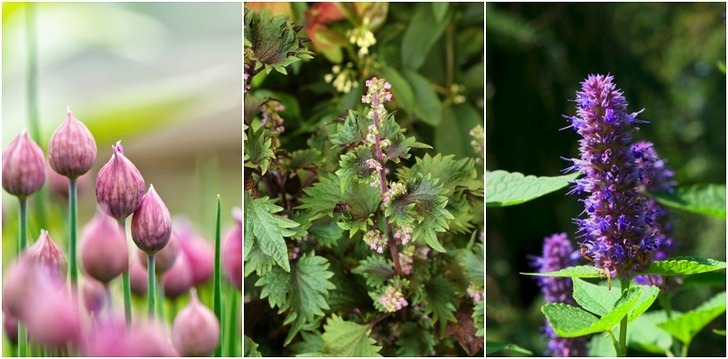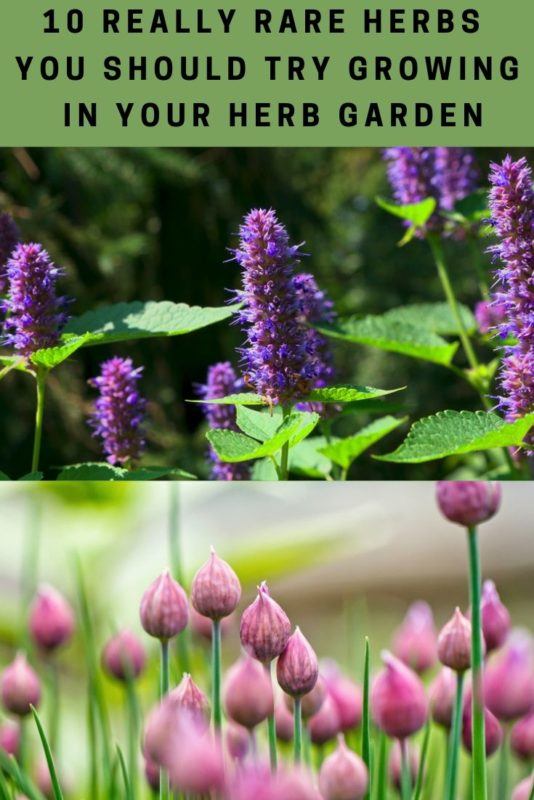
There are few things better than relaxing in your own beautiful herb garden, enjoying the aroma of sage and lavender while sipping on a cup of mint tea. But why not change that up a bit? You could even find yourself sipping on a chocolate mint tea while taking in the scent of orange thyme. Rare herbs like this take the fun of an herb garden up a notch.
While herbs like parsley, basil and thyme are indispensable in the kitchen, you’ve probably already got them growing in abundance. Now it’s time to grow some more unusual herbs, herbs with exotic flavors, intrigue, and all sorts of medicinal benefits too.
1. Siberian chives
Siberian chives are similar to ordinary chives, but they have a buttery onion flavor and mauve flowers that can not only add flavor to a salad but can beautify it too. In your herb garden, they’ll provide months of color, and the round purple flowerheads are a great way to attract both bees and butterflies, while the plant’s scented foliage deters pests.
Use the flat leaves of Siberian chives just like you would use ordinary chives. You can also slice the hollow stems and add them to soups, potato dishes, Mexican fare, and of course, salads – they’re especially gorgeous this way. Just some of the health benefits they offer including strengthening the immune system, supporting heart health, boosting bone strength and improving vision.
2. Sweet cicely
Sweet cicely is native to the British Isles and used to be grown in kitchen gardens near the door for easy access. It’s also famously used by Carthusian monks to make the liqueur, Chartreuse. In the plague years, people used it to prevent infection. All parts of the plant can be used – it’s been used for centuries for both culinary and medicinal purposes. Sweet cicely has a similar taste to aniseed, and it also helps to reduce the acidity of other ingredients in cooking. It’s ideal for adding to something like cooked apples, as it adds a touch of sweetness which means you won’t have to use as much sugar. You can cook the roots like you would parsnips and use them to flavor up soups and stews, and the leaves as a garnish or in salads.
This herb is especially good for the digestive system, when mixed into boiling water with a little finely chopped dinner, it creates the perfect concoction for relieving digestive issues like flatulence.
3. Toothache plant
The toothache plant does just what it sounds like – it makes your mouth go numb when you chew the leaves to help relieve the pain of an aching tooth. It has pretty yellow and red cone-shaped flowers, and its leaves have beneficial properties that are similar to echinacea, including boosting the immune system, relieving nausea and improving digestion. Its other rather unique in its appearance in that it has oddly-shaped flowers which resemble miniature eyeballs.
Spilanthes acmella, as it’s officially known also offers antibacterial and antifungal properties that make it a good purifying herb, used for disinfecting wounds and curing ringworm infections – it’s even been used as an antiparasitic and native remedy against malaria in the tropics. The flower buds and fresh leaves can be made into a tea, chewed or steamed and eaten as salad greens.
4. Epazote
Epazote is not something that’s easy to find in American grocery stores, and most people in the U.S. have never even heard of it, but it’s a dominant herb in Mexican cooking. While it’s most commonly considered to be an herb, and is popular for making a spicy tea, it can also be prepared like a leafy vegetable and used in chilies, egg dishes, tamales, quesadillas or soups. The flavor itself is unique, both minty and peppery, though some liken it to a citrus or tarragon-like taste.
Epazote contains an extensive array of vitamins and minerals, including vitamins A,B and C, as well as calcium, manganese, copper, iron, magnesium, potassium, phosphorous, and zinc. It can help relieve cramping, bloating and constipation in addition to enhancing the immune system and protecting the body’s cells against free radical damage to lower the risk of a number of certain cancers and other chronic diseases.
5. Perilla
Perilla is relatively unknown outside of Japanese and Chinese cooking, but it makes an attractive addition to salads and a variety of other dishes. Its flavor is somewhat grassy with notes of anise or licorice, a bit like a blend of cumin and mint, though the real advantage is their size. You can do more with the bigger leaves than just chop them up and use them as a garnish. The leaves can be stir-fried with garlic and veggies, deep-fried in a batter of flour and eggs, pickled or marinated, or used as wrappers too.
Due to its strong smell, you can rub the leaves on your skin and clothes to repel ticks. The entire plant is very nutritious, loaded with vitamins and minerals, particularly vitamin C, containing nearly half the daily recommended amount. It also offers 23 percent of the daily suggested intake of calcium, while the leaves provide anti-inflammatory effects and help promote healthier cholesterol levels.
6. Chocolate mint
Here’s the one you’ve been waiting for – did you know that a chocolate mint herb even existed? It really does, and it’s just as scrumptious as it sounds. It smells like a peppermint patty, though the aroma is more chocolatey than the taste. It makes a fabulously indulgent tea, and it can be baked in cakes, added to mojitos and used to relieve digestive woes, just like ordinary mint. Its aroma, though pleasant to humans, repels pests like mice, mosquitoes, fleas and flies.
Use the essence of chocolate mint to make your own infused oil that can be added to a favorite homemade body scrub, face mask or other beauty products for added chocolate indulgence.
7. French sorrel
In the ancient world, sorrel was a very popular, well-liked culinary herb, and since sometime around the 14th century, it’s been extensively used in both the form of a salad plant and a vegetable. It’s less acid in flavor than common sorrel, with a distinct tang of apple and lemon, and has a high-level nutrition. French sorrel is particularly rich in antioxidants and vitamin C, as well as being a good source of vitamin A, which helps to strengthen the immune system and prevent premature aging too.
French sorrel leaves are often used for their medicinal properties, including the ability to prevent or relieve diarrhea and constipation, as well as to lower the risk of heart disease, diabetes, cancer, and hypertension. It can be eaten raw like spinach as part of a salad, added to sandwiches, or even pureed into a soup.
8. Anise hyssop
Anise hyssop has a minty anise seed flavor that’s fresh and sweet. Part of the mint family, it’s both attractive and aromatic, making it popular as a beautiful garden plant. It’s been long used by North American First Nations people as a sweetener, tea and breath freshener, and in Chinese medicine, it’s used to treat fever, headache, heat stroke and angina. When your nerves are frazzled, you can place fresh or dried anise hyssop leaves in some cheesecloth and hang it from your bathtub faucet, allowing the water to flow over the herbs as the scent helps create a calming sensation.
The leaves and flowers of the plant also make a delicious black licorice flavored tea for treating colds by helping to relieve congestion, and can be added to salads, or dried and used to complement poultry, salmon and lamb dishes.
9. Orange thyme
Most of the time it seems that fruit-flavored herbs smell wonderful, but disappoint when it comes to flavor. Orange thyme is an exception, with its fantastic warm citrus taste that complements thyme. Its strong citrus tang leaves no bitter aftertaste making it an excellent flavoring herb for stuffings and casseroles – it goes fantastically well with lamb and duck too. You’ll get the same benefits of ordinary thyme, which a long history of use in natural medicine for treating coughs, chest congestion, and bronchitis, as well as lots of vitamins A and C. It’s also a good source of manganese, copper, iron and fiber.
10. Mexican tarragon
This Central and South American herb has been used for both medicinal and culinary purposes for centuries. It’s a powerfully psychoactive species of marigold, which was used as a ritual incense by the Aztecs – today, it’s used in the Dia de Los Muertos festivities in Mexico as an offering to the deceased, as well as being a very popular beverage throughout Latin America. The leaves and whole plant are known to help relieve digestive woes, including diarrhea, nausea, and hiccups, while the flower petals can be used to make a tea to treat cold symptoms.
In cooking, Mexican tarragon offers a complimentary savory flavor to meat and egg dishes. It’s also a very beneficial plant for your garden, attracting bees and butterflies while repelling many insects.
Pin This To Save For Later

